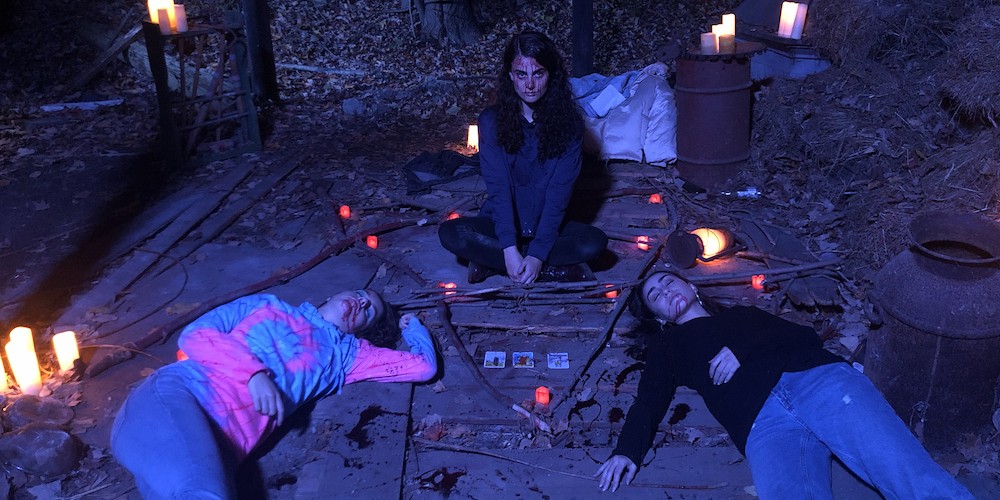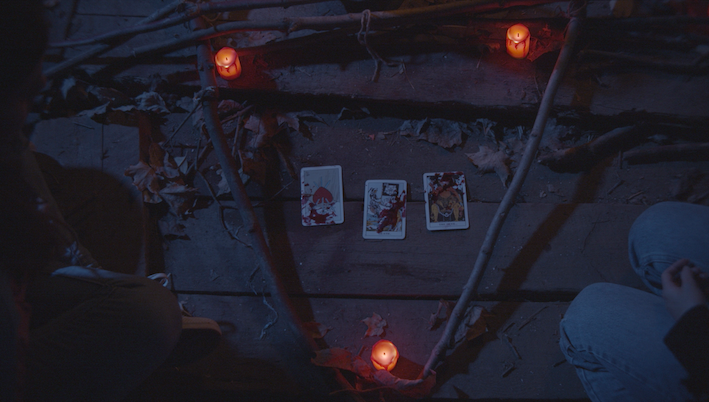Behind the D4: ‘The Midnight Girl’
Behind the D4 is an interview series about the D4 films made by Film MFA Program students. After completing their Directing IV coursework, each student is required to direct a short final project, called the “D4 Film.” Because of the COVID-19 pandemic, films that would have been filmed during the Summer of 2020, began shooting in September 2020.
The Midnight Girl
Kendall, a shy new girl at school, is invited on a trip by the two popular girls, Sam and Cally. The three girls search for an abandoned and haunted barn that is the site of a local legend. Once they arrive there, the girls get more than they bargained for when they play a game of tarot.
Cast and Crew
Writer and Director: Dhruv Sud
Producer: Elizabeth Grupp
Cinematographer: Rodrigo Arias
Safety Manager: Hazel McKibbin
Grip: William Turner
Assistant Director: Mathilde Hauducoeur
Cast: Kira Bierly, Brooke Brazer, and Stephanie Mautone
How did safety restrictions affect your creativity?
Student Dhruv Sud (DS): I was very aware that things like that would never fly for risk management, so I had to change certain things in the script. All three actresses came from different places, and having them touch each other was a big risk, and I did not want them to feel uncomfortable. On the other hand, I was so mad when I found out about the "no touching" rule because it is so antithetical to acting. When actors have an emotion or a need to be intimate with each other in the scene, they should have the freedom to do that because that is how we get good performances. But in this short, we just had to be very creative and precise with blocking to avoid any physical contact, which could put us all at risk.
Student Hazel McKibbin (HM): Even though we had a limited crew and various limitations, we all managed to get together and do it, and that is one of the things I am most proud of about this shoot. It brought it back to shooting "little" exercises at the very beginning of Columbia when we had four crew members and one actor, and sometimes they turned out pretty great. And this shoot was back to that, just focusing on the essentials like the story and getting it to look amazing.
Student Rodrigo Arias: Since there was a limited number of people that could be on set, I had to do most of the lighting myself. Also, we were short on the equipment, and I didn't choose most of the items. It was just working with whatever we had. But I wanted to do it, either way, like it or not.
Student Elizabeth Grupp: The first thing we did was deciding the date, texting people to get the crew, and the next day Dhruv started writing the script. And basically, he would be writing the script, and I would be working on the schedule and the PAB going back and forth with Jenny [Tromski, Director of Risk Management and Production Administration]. It was rapid-fire pre-production, but in the end, we managed to prepare everything on time, and those sleepless nights we quickly forgot.
How did Zoom casting change your process?
DS: I think it works even better. You can see actors reacting to a camera and others who are not, and in person, you can easily get tricked. Sometimes you think, “oh my God, this performance was outstanding,” but it doesn't translate to a camera. And that happens all the time with actors. But then, on Zoom, you’re already seeing through a camera, and if they're doing it well -- having micro-expressions or all those little things that are so camera dependent -- you won't have any unpleasant surprises when you put them in front of the camera.
Actress Brooke Brazer (BB): When you have a Zoom audition, all of a sudden, you have to worry about lighting and the position of your laptop, usually getting a little closer to a camera, so they could see your expressions because filmmaking is very close-up. On the other side, the most challenging thing over Zoom casting is getting a sense of a person or someone you want to work with, especially during those strange times when a sense of trust became the most important thing. Fortunately, Dhruv was such a sweetheart, and our collaboration came up pretty well.
Actress Stephanie Mautone: Due to the new circumstances, I had to invest in a few things that can improve Zoom performance. So, I bought a laptop stand, some lights, and a few little things you would never think about in the audition room. If your camera angle is awkward and your eye line off, you will look horrible no matter your performance. Nowadays, you have to think about those things before starting the audition.
What advice would you give for filmmakers and actors during this time?
DS: We will have time to do those deep passion projects that we feel strongly about, but I don’t know if this is the right time unless your film exists in the world of COVID. People need to make sure that whatever they are writing could be made under these restrictions without compromising their vision or anything essential to the movie.
HM: Be creative with how you use your crew. [Due to Columbia’s policies at the time] we could have only seven crew members on a set, but you still need someone to think about the wardrobe or do the hair and makeup. You have to figure out who on your crew can do that and also do sound or lights. Just give yourself more time, so you can allow people to do multiple jobs.
BB: I do take this very seriously, and as an actor, I am so eager to work more and do another project, but don’t make sacrifices for your safety to take a job. Have that standard for yourself, and don’t be afraid to advocate for it on set because this is a global pandemic, and you are setting a good example and holding the crew accountable, and I think that is just so important.



